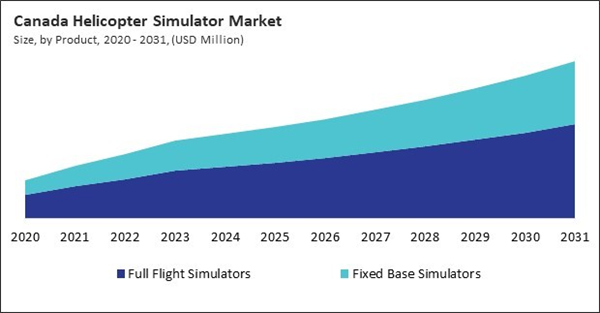The North America Helicopter Simulator Market is expected to witness market growth of 7.0% CAGR during the forecast period (2024-2031).
The US market dominated the North America Helicopter Simulator Market by country in 2023, and is expected to continue to be a dominant market till 2031; thereby, achieving a market value of $510.2 Million by 2031. The Canada market is experiencing a CAGR of 9.3% during 2024-2031. Additionally, the Mexico market is expected to exhibit a CAGR of 8.4% during 2024-2031.
Military forces use helicopter simulators for pilot training, mission planning, and operational readiness. These simulators allow pilots to practice combat maneuvers, emergency procedures, and mission-based scenarios without the risks associated with live training. Military-grade simulators replicate real-world combat environments, including enemy threats, weather conditions, and terrain obstacles. Helicopter simulators are widely used by aviation training institutions and commercial helicopter operators for pilot certification and skill enhancement. The increasing demand for skilled helicopter pilots, particularly in industries like offshore oil and gas, tourism, and cargo transport, has driven the adoption of simulation-based training programs.
Moreover, helicopter simulators are crucial in training emergency medical and search & rescue teams. These simulations help pilots and crews familiarize themselves with high-stress situations, such as navigating extreme weather conditions, landing in confined spaces, and coordinating with ground teams during emergency evacuations. Many law enforcement agencies utilize helicopter simulators to train officers in aerial surveillance, pursuit operations, and emergency response missions. Simulators provide realistic training scenarios that help pilots develop critical decision-making skills in high-risk situations.
The market in Canada is poised for growth, supported by significant government investments in the aerospace sector. The Aerospace Regional Recovery Initiative (ARRI), with a total budget of $250 million, is driving innovation, workforce development, and technological advancements within the aviation industry. This initiative, delivered by Canada's regional development agencies (RDAs), complements broader government support, including funding from the Strategic Innovation Fund and the COVID-19 Economic Response Plan. As Canada strengthens its aerospace capabilities, the demand for helicopter simulators is rising to meet the increasing need for pilot training, operational safety, and advanced simulation technology.
The US market dominated the North America Helicopter Simulator Market by country in 2023, and is expected to continue to be a dominant market till 2031; thereby, achieving a market value of $510.2 Million by 2031. The Canada market is experiencing a CAGR of 9.3% during 2024-2031. Additionally, the Mexico market is expected to exhibit a CAGR of 8.4% during 2024-2031.
Military forces use helicopter simulators for pilot training, mission planning, and operational readiness. These simulators allow pilots to practice combat maneuvers, emergency procedures, and mission-based scenarios without the risks associated with live training. Military-grade simulators replicate real-world combat environments, including enemy threats, weather conditions, and terrain obstacles. Helicopter simulators are widely used by aviation training institutions and commercial helicopter operators for pilot certification and skill enhancement. The increasing demand for skilled helicopter pilots, particularly in industries like offshore oil and gas, tourism, and cargo transport, has driven the adoption of simulation-based training programs.
Moreover, helicopter simulators are crucial in training emergency medical and search & rescue teams. These simulations help pilots and crews familiarize themselves with high-stress situations, such as navigating extreme weather conditions, landing in confined spaces, and coordinating with ground teams during emergency evacuations. Many law enforcement agencies utilize helicopter simulators to train officers in aerial surveillance, pursuit operations, and emergency response missions. Simulators provide realistic training scenarios that help pilots develop critical decision-making skills in high-risk situations.
The market in Canada is poised for growth, supported by significant government investments in the aerospace sector. The Aerospace Regional Recovery Initiative (ARRI), with a total budget of $250 million, is driving innovation, workforce development, and technological advancements within the aviation industry. This initiative, delivered by Canada's regional development agencies (RDAs), complements broader government support, including funding from the Strategic Innovation Fund and the COVID-19 Economic Response Plan. As Canada strengthens its aerospace capabilities, the demand for helicopter simulators is rising to meet the increasing need for pilot training, operational safety, and advanced simulation technology.
List of Key Companies Profiled
- Thales Group S.A.
- TRU Simulation + Training Inc.
- Frasca International, Inc.
- Airbus SE
- Reiser Simulation and Training GmbH
- CAE Inc.
- FLYIT Simulators, Inc.
- iSim Limited
- Moog Inc.
- L3Harris Technologies, Inc.
Market Report Segmentation
By Product
- Full Flight Simulators
- Fixed Base Simulators
By Application
- Military
- Commercial
By Country
- US
- Canada
- Mexico
- Rest of North America
Table of Contents
Chapter 1. Market Scope & Methodology
Chapter 2. Market at a Glance
Chapter 3. Market Overview
Chapter 4. North America Helicopter Simulator Market by Product
Chapter 5. North America Helicopter Simulator Market by Application
Chapter 6. North America Helicopter Simulator Market by Country
Chapter 7. Company Profiles
Companies Mentioned
- Thales Group S.A.
- TRU Simulation + Training Inc.
- Frasca International, Inc.
- Airbus SE
- Reiser Simulation and Training GmbH
- CAE Inc.
- FLYIT Simulators, Inc.
- iSim Limited
- Moog Inc.
- L3Harris Technologies, Inc.
Methodology

LOADING...









